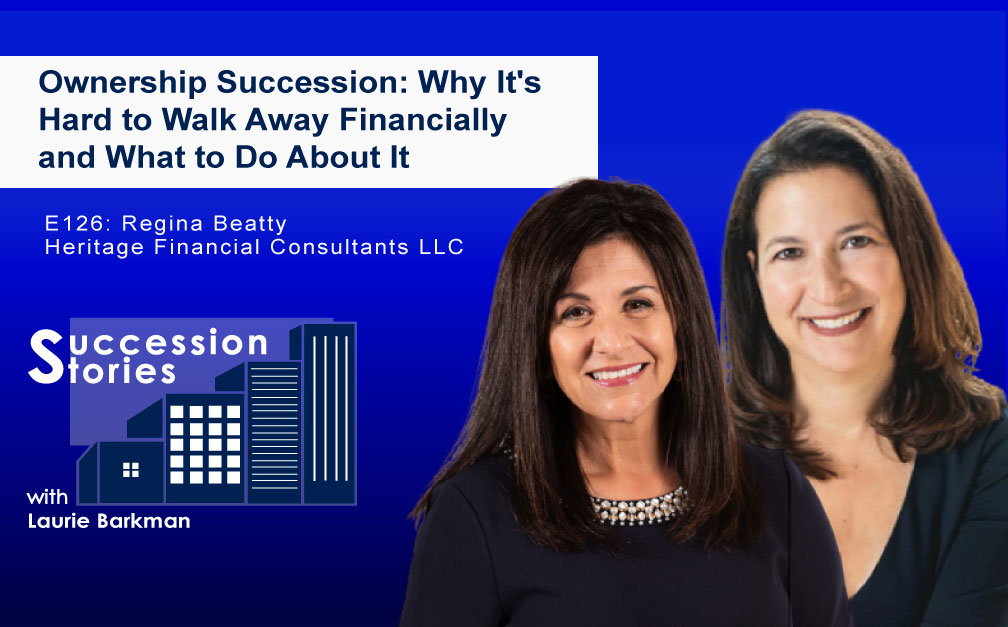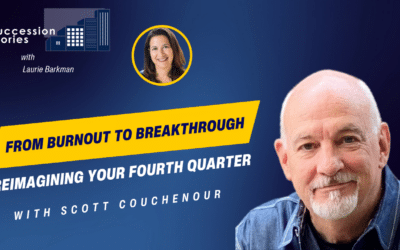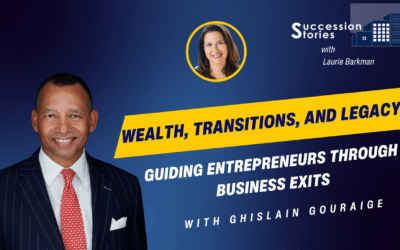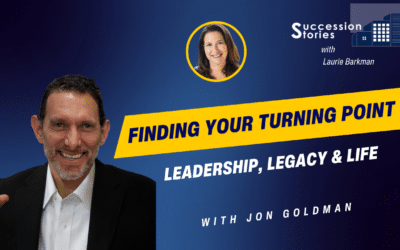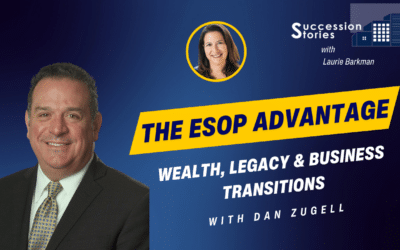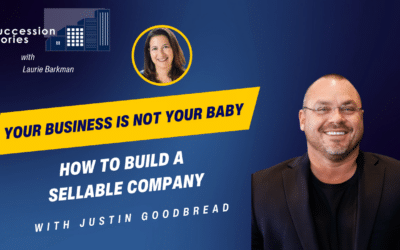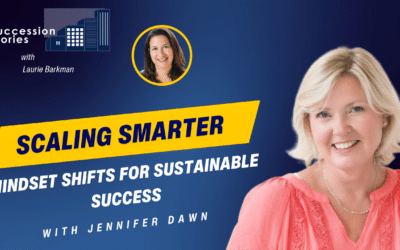Are you prepared for the emotional realities of succession planning? Regina Beatty, an advisor with the financial planning group, Heritage Financial Consultants, joins Laurie Barkman on Succession Stories to discuss how to prepare and transition a business to the next owner, while navigating the financial and emotional challenges associated with transitioning from a family-owned business.
Listen in to learn more about:
- Top concerns for business owners looking to exit
- How to minimize the tax impact of succession
- How to start a legacy plan
Guest and show notes:
- distinctivewealthstrategies.com
- Regina.Beatty@LFG.com
- Regina Beatty is a Registered Representative of Lincoln Financial Advisors. Securities and investment advisory services offered through Lincoln Financial Advisors Corp., a broker/dealer (Member SIPC) and registered investment advisor.
- New York Times, “When Your Career, and Retirement Are The Family’s Business” https://www.nytimes.com/2023/03/25/business/family-business-retirement-succession-New York Times
More business transition resources:
Grab a copy of “The Business Transition Handbook” for yourself at https://amzn.to/3Hqj2eo
Download the official workbook to help you plan your transition as you read at https://thebusinesstransitionhandbook…
Follow the Succession Stories YouTube Channel https://www.youtube.com/@successionstoriespodcast
Follow Laurie Barkman on LinkedIn: https://www.linkedin.com/in/lauriebar…
If you enjoy Succession Stories, please leave a review. Reviews help us reach new listeners, grow the show and continue creating content you’ll enjoy. Please click here to leave a review.
About Succession Stories Podcast
Succession Stories is an award-winning podcast guiding entrepreneurs from transition to transaction.
Hosted by Laurie Barkman, author of “The Business Transition Handbook: How to Avoid Transition Pitfalls and Create Valuable Exit Options.”
Learn more about Laurie’s strategic business transition planning and M&A advisory services by visiting: https://thebusinesstransitionsherpa.com
Transcript:
Laurie Barkman:
Regina, welcome to Succession Stories. We are hearing so much about succession in the news lately. I know the New York Times is doing pieces on it. There’s companies that are having succession every day, it seems it’s in the news, and of course there is HBO’s Succession in its last season. It’s a topic that’s emotional, it’s financial, you’re a great person to have on the show to dive into this topic. So welcome.
Regina Beatty:
Thank you, Laurie, great to be spending time with you today.
Laurie Barkman:
Let’s focus on the things that are top of mind for business owners. What do you hear most often?
Regina Beatty:
What we hear most, the three top things that are on the minds of our business owner clients when we first meet them, is first recruiting, but more importantly, to retain top talent, how to manage the IRS tax fight and how to get money out of their business to help them secure a carefree retirement.
Laurie Barkman:
Yeah, those are really common things, especially with the quiet quitting. It’s a big topic and the work environment is changing so much, so there’s no doubt that business owners are worried about the economy, they’re worried about their people being happy, they want to retain they want to grow, and they’re worried about the dynamics of the financial system and what’s happening with with interest rates, it’s weighing in a lot of people’s mind, I think, particularly around this idea of financial security going forward. It’s a big time of uncertainty, don’t you think?
Regina Beatty:
Absolutely. With many of our business owners, baby boomers reaching ages where they’re starting to finally think about retirement, things have changed, the dynamic has shifted. Years ago, someone would say, “I’m going out feet first.” Now you hear people saying, “I wonder what the next phase of my life is going to look like outside of my business.”
Laurie Barkman:
You work with a lot of business owners. Tell me a little bit about that. What is the dynamic of how you work with business owners, and in your practice, just give a little bit of background?
Regina Beatty:
Yeah, so financial planning for a business owner encompasses a whole realm of considerations. One of them is most of our clients, the majority of their wealth is tied up in their business. Working with them to help them coordinate both their personal objectives alongside and coordinate with their business objectives is one of the things that we most often experience in a relationship with our clients. That’s where exit and succession planning end up coming in. Because in its purest sense, succession planning really is retirement and legacy planning so we find that when we work with what’s on their minds, we end up working on how to coordinate the both of them to make sure that we’re putting them in a situation to tee them up for success, even after they exit their business.
Laurie Barkman:
The New York Times article that came out in March, was a good article to talk about broad strokes and I don’t know if anyone’s read it, who’s listening and just in high level, people are thinking about the best way to exit and when should they exit? That was really the premise and they gave some examples. I’ll put a link to the article in the show notes and there’s lots of articles out there and there’s no exact timing, there’s no exact way to do it. There’s no one way to do it. You see it all in your examples of working with clients, what do you think are some of the best ways to exit in your experience?
Regina Beatty:
It’s interesting, Laurie, it’s different for everybody and that’s what makes exit and succession planning so exciting is that every single situation is unique and some people have family members in the business, but also family members out of the business. You have key employees that have been there since college, or you recently hired someone that’s a key member of the team that’s really taking your company by storm and doing a great job and in today’s space, right? We find so often the desire to explore selling to an outsider with private equity groups actively and aggressively pursuing businesses for growth. There’s so many different ways and we find that often we find some combination as the best solution for certain situations so a gift or a transition to family and internal transition to key employees or key performers and a family member. A sell to and outside or a combination thereof our primary goal is how to help the owner experience a smooth and orderly transition, regardless of the method that works best for them.
Laurie Barkman:
What are your takeaways from these methods? Do you think that it’s a 10 year process or a 20 year process, five years? What if people are running out of time?
Regina Beatty:
Every situation is different, as you know and I think that it’s never too early to have a succession plan because there are life events that happen premature death or disability, that without a succession plan can create a fire sale, something that no owner wants to experience but for someone looking at their business, trying to either drive profit, so that they can sell and get a nice multiple to an end sell to an outsider, or an internal transition on how to have the book value worked best and still provide an earnout or cash flow to the owner. As we work through that, I believe that a sweet spot for succession planning is somewhere between five to seven years. Now that’s changed a little bit with a pandemic, it kind of changed our thought process a little bit, that may be closer to seven years, rather than five to seven but that doesn’t mean we don’t have situations where you know, something happened. There’s a family event or a life event that we have to quickly get things together, and maybe only have nine months to a year to make something happen and we still look for creative ideas, and help our clients find ways to best get the most tax efficient money out of their business when they’re trying to monetize
tax efficiency.
Laurie Barkman:
Let’s talk about this IRS tax fight. You mentioned it and the top three things earlier, what business owners need to be thinking about to minimize this tax bite.
Regina Beatty:
When we look at taxes, and we look at revenue and cash flow, more often than not, it’s not what you make, it’s what you get to keep or what you make that really matters. There are many different avenues that our clients get year-end tax planning, where they run out and buy a whole bunch of equipment, because they know they can use it someday, rather than writing the check to Uncle Sam and then in many cases, we have the self employed pension the set plan for you know, your one or two man, employee, shop, man or woman, really and then you look at simple IRA, which is a low cost way to have some type of retirement plan for an employer or the 401 K with either safe harbor or profit sharing discretionary or mandatory.
Those are some of the typical ways that most of our clients find ways to either defer money before taxes, or to make big purchases to reduce taxation but that doesn’t always work, the big purchase at the end of the year, it doesn’t always work when you’re trying to sell your business in a few years, because now you’re reducing your profit, which is going to reduce what it looks like you’re going to be worth to an outside buyer.
There’s a very, very delicate balance there, that your whole advisory team, including someone like me, someone like you, Laurie, the CPA and the attorney working on all of it together to determine the best combination method and giving that proactive advice to make sure that you’re not shooting yourself in the foot by buying three or four great big pieces of equipment, writing them all off in one year. Going from there, one of the options that we have found that is working very, very well for our clients that they don’t typically get advice on is a bolt on to a 401 k or a standalone cash balance plan, so a cash balance plan is a defined benefit plan and if structured properly, for the right company, and the right owner can really take huge advantage of how this plan works to be able to pay yourself first and put more money away before tax, but at the same time helping your employees because you’re giving a value add that’s a little different than what most employers provide.
Laurie Barkman:
I don’t know a lot about this plan. We haven’t talked about it on the show you and I talked about it off air. This is called a cash balance plan. Correct?
Regina Beatty:
Yep.
Laurie Barkman:
Okay, so this is kind of a big deal. I think we should dive in a little bit deeper. Okay, can you give us a little more of a flavor or some examples of how it’s worked for some of your clients?
Regina Beatty:
Sure. Let’s first talk a little bit about what it is right? It allows the owner the ability to put away more money pre tax each year than would a traditional retirement plan, the cash balance portion of a plan, because it is a design, it’s a defined benefit plan that in conjunction with a traditional 401k will use factors to exponentially increase the allowable deductible contributions and then when we do business owner planning with our clients, we often do this valuation study that comes with a cash balance plan to determine whether or not it makes sense so that that is you need a third party administrator coordinating with someone like us to determine whether or not it’s a good fit for that particular business.
Laurie Barkman:
Talk a little bit about what are the dynamics for people who are in the plan or leave the plan? There’s always ins and outs of all of that, sure that you end a plan, like, what are some of the mechanics of this? If someone’s thinking, “Oh, wait, this could be interesting for us to put more into savings and help our employees,” but even the math, like how does this work? Or what’s the nest egg that they could benefit from?
Regina Beatty:
Okay, so the 401k is a defined contribution plan, meaning that you put money in there’s going to be a match more often than not, maybe some profit sharing and it the underlying assets in the plan are professionally managed investments and so it’s a defined contribution what you can put in what your match is going to be, but it’s undetermined, what it’s going to be worth in the future, because what we’re defining in the plan document is what the contributions will be. In a cash balance plan, it works the opposite, it’s a defined benefit plan so factors like age of the owner, and or spouse if they work in the business and then the rank and file employees using factors related to age time horizon to retirement, and what the average earnings of the business is or a forecasted earnings.
The third party administrator does a calculation, a valuation study that will determine how much can be put in and I’ll use an example. We have a client, they’re in their 50s, husband and wife both work there, they have a 401 K with profit sharing, and they have six employees because the owners are a little bit older, and closer to retirement, the plan works in their favor, because they are the highest compensated employees in the business. In their situation, they were able to defer 200 and some 1000 and give away 30,000. They benefited 90% of the check that they wrote. For this plan, they benefited before tax and a 37% tax bracket, they saved $100,000 in taxes, they gave away 30. On a vesting schedule, the employees just don’t have access to this money. It’s just like any other like a 401 k where you have a vesting schedule that you determine so if they leave prematurely, they will forfeit part of the contributions that were made on their behalf but every year we go through this valuation study based on what the financials look like at the end of the year, and then determine what the maximum contribution can be for that year.
Laurie Barkman:
I want to go back to legacy planning. We do talk about this topic a lot on the show and there are different goals that a family may have to transition to the children transition to siblings, the larger the family becomes it can be more complex, especially if there’s blended families, which you mentioned before and this is their biggest asset and I talk with a lot of clients about options. I think it’s good to create options and when time is on your side, you have more time to effectuate a plan and decide a path forward. But this can be very emotional. This is not an easy thing to do, especially if the next generation is not well suited to be in the business so you might have people that are operators. I was just talking to a brother, his other brother is out of the business. He’s in the business. He’s active. He wants to buy from the parents but it’s very fraught with emotion, that there’s a disagreement potentially between the two brothers and what they believe they each should have in terms of the transition, so what’s the upshot? What’s the question? I guess the question to you is, in your practice, when you are working with business owners, and you can feel the emotion in the room, how do you start the conversation about their vision? If it’s the parents or whoever you’re speaking with, how do you get them to shape out a vision for their legacy and start to work through some of these challenging dynamics?
Regina Beatty:
It’s interesting that you say that, Laurie, because as you’re telling the example, all of my emotions are like all over the place, right? Because we’re in this situation often and in our practice, we actually go through what we call emotional intelligence training because it is complicated. Families don’t look like what they used to before. It’s not The Cleavers, where you have the mom and the dad and the two kids. I mean, you have blended families, you have special needs, I mean, with the epidemic of adult children, and more are coming that are on the spectrum, or emotional disorders or substance abuse disorders on top of some children are well suited to be in the business, and some just aren’t.
We go through a defined process, where we empower our business owner families to share with us what keeps them up at night and we find the best way for them to share that information. Sometimes it’s the husband and wife both in the room, sometimes they each want their own session and that’s fine, we need to help them figure out the safe space to talk about what keeps them up and their worries, because their business is their largest asset and it’s so important that we dig down deep, and figure these things out. We, as the advisors, come up with creative design ideas so that they’ve moved forward with clarity and confidence and without this unknown monkey in the room that they were afraid to talk about.
Often, if they don’t talk about it prior to, even with the greatest deal, it’s going to fall through at the 11th hour and that happens so often so we try to make sure that we’re proactive and we do ask those questions and it’s interesting, because when we go through the four key areas of personal planning, which is retirement planning, estate planning, investment planning, or succession planning. The minute they say succession, retirement or estate, it helps us dig into that just a little bit deeper. “Tell me about your family, husband, wife, daughter, daughter in law, son in law, are they in laws or outlaws?” That simple question can develop into a huge conversation that helps us be better informed, so that we can eventually bring better ideas to the table.
Laurie Barkman:
In laws or outlaws? It’s a kind of put that in quotes, like they’re not literally in jail but that’s right, a lot of relationships are strained. That’s right. The other thing that comes to mind from the New York Times article was the use of insurance and you didn’t mention it in your earlier comments, I just wanted to bring it up, because I know you do work as a registered insurance advisor, and what one of the families had encountered in that article was that the child who was working in the business was being gifted shares of the of the company, whereas another child was written into an insurance policy so that if and when the parents passed away, that some wealth will transfer to the other child, but in a different way and you and I have talked a little bit about the power of insurance. It’s not something you can necessarily say, is a fit for everything. I know that but maybe you could share again, some examples of what you’ve seen, or how insurance can help in these situations.
Regina Beatty:
Absolutely. Insurance, this is what we call the great equalizer, and yto have a child in the business and a child not in the business, you’re right, having insurance to benefit the child not in the business, equalizes their inheritance, but let’s take it a step further. Let’s talk about a blended family. You have children in the business, the spouse owned the business prior to the marriage, and now you have the new spouse that’s living this lifestyle, and the children may not want dad’s second wife in the business that happens all the time.
Well, having insurance structured properly to benefit the wife allows her to not even need to be in the business to sustain the standard of living She’s come accustomed to so there are so many things but one thing that’s really important when considering insurance, it’s not just running out there and grabbing insurance because insurance also, it helps equalize for partners but if not structured, structured properly, insurance becomes part of your taxable estate and it’s so important to work with an insurance professional, and most financial planners, certified financial planners, are insurance professionals as well. Because not structuring it properly can create a whole other set of issues after a death, which is the most stressful time for a family in the first place.
Working with someone who understands how to properly design it is also a way to help key employees buy into the business, there are so many different uses of insurance, or golden handcuffs. Some of our business owners want to take care of some of their key employees and they put insurance policies on them that help benefit their families but the insurance, the business owner can recover part of the premium that they pay or not if they choose not to. There are so many reasons that insurance becomes a very viable planning tool but remember, a lot of people say, “I don’t believe in insurance.” It’s not a religion, it’s just a tool and if it’s used effectively, it can help solve a lot of problems in a succession situation but if used ineffectively, it can be your worst nightmare, so it’s really important that it’s structured properly.
Laurie Barkman:
Yeah, that’s probably worth noting. You and I today have been talking a lot about transition to the next generation and keeping it within the family but if insurance policies can also be a tool, and the planning process, just in general, for the whole conversation, not just this insurance piece of it but the whole idea about proactive planning and how to think about the tax implications is good for owners, when they want to sell to a third party also so I don’t want listeners to think, “Oh, this is only if I’m going to transition to my family.” I think it’s also very useful for the conversations around management selling to a third party or selling shares and gifting shares, whatever the methodology is going to be to transition it to management and the insurance is going to be super helpful, because the buyers are going to want to know that if let’s say it’s a private equity group, or a strategic company who’s going to acquire the business, they want to know that the management team is intact and ready to move over and so the golden handcuff phrase that you use is really important; these incentives to stay.
Regina Beatty:
That’s right, we have a company that we work with. This is a fun example, that we had done golden handcuffs policies about seven years ago, for their young management team so it was inexpensive, they were putting six and 8000, depending on the positions away a year for each of these employees and we used a loan regime that if they left prematurely, they would owe the money back, which was fine, they were happy to have the insurance, it builds cash value. Well one of their key people has been approached every single year for the last three years by competition and he cannot walk away from the cash value. He has a 15 -year agreement before it’s fully vested. That’s the nice part about insurance, you don’t have a risk of rules in there, and things like that and he just cannot walk away because the cash value keeps growing and that’s money he would be taking away from his family so it’s funny, we have the review every year or they’ll call and say, “Hey, you need to have a talk with him. He needs to understand what he’s giving up. Because we have a feeling he’s being talked to again.” It really does work so it’s kind of fun to see it in action. Insurances triple net tax free if it’s designed appropriately so that’s also an important consideration.
Laurie Barkman:
Well, let’s wind down and kind of begin where we started. I asked you this high level question about what’s on top of mind for business owners today and we’ve spent a lot of time talking about how to minimize tax implications but really this bigger picture of legacy, so if you’re going to summarize and for business owners who are listening and say, “Hey, here’s three things that are very actionable.” What would you say as advice, what should they start doing right now?
Regina Beatty:
Well, I think the first thing is engaging with a planner. Understanding the coordination between personal and business planning the two together are critically important to be done together. That’s the most important thing and exploring the different ways how to most tax effectively get money out of your business onto your personal balance sheet. If that’s very, very important, and we find that top of mind all the time, there are 13 ways to get money out of your business, and then lastly is ensuring that your business succession plan coordinates with your personal retirement plan and your legacy plan to help you take care of yourselves, your family, for now and also into the future.
Laurie Barkman:
Awesome. Regina, I ask everybody if they have a favorite quote, something that inspires you, as a leader, as an entrepreneur, someone who works with entrepreneurs, is there anything top of mind for you?
Regina Beatty:
Well, there are so many because there again, all the top of mind and everything else, but for me, I feel like it’s more what we try to do. I feel like if you help take care of your clients, and who and what they care about, right, who and what they love, that you will always feel good that you’re doing a good job and that’s what we try to do. We want our business owner families to know that they’re taken care of, but also their families and their employees.
Laurie Barkman:
If people want to follow up to get in touch and learn more, what’s the best way to find you?
Regina Beatty:
Okay, our website is distinctivewealthstrategies.com or email regina.beatty–Like Warren Beatty–@lfg–L as in Larry, F as in Frank, g as in girl–.com.
Laurie Barkman:
Awesome, and we’ll put that in the show notes, of course. Regina, thank you so much for being on the show with me today. It was a pleasure speaking with you and I look forward to more conversations together.
Regina Beatty:
That’s awesome. Laurie, it was a pleasure as well.
Laurie Barkman:
To the listeners, thank you so much. Be sure to follow Succession Stories on your favorite podcast player or YouTube. To maximize the value of your business and plan for future transition, reach out to me for a complimentary assessment at meetlauriebarkman.com. Join me next time for more insights from transition to transaction. Until then…here’s to your success.

